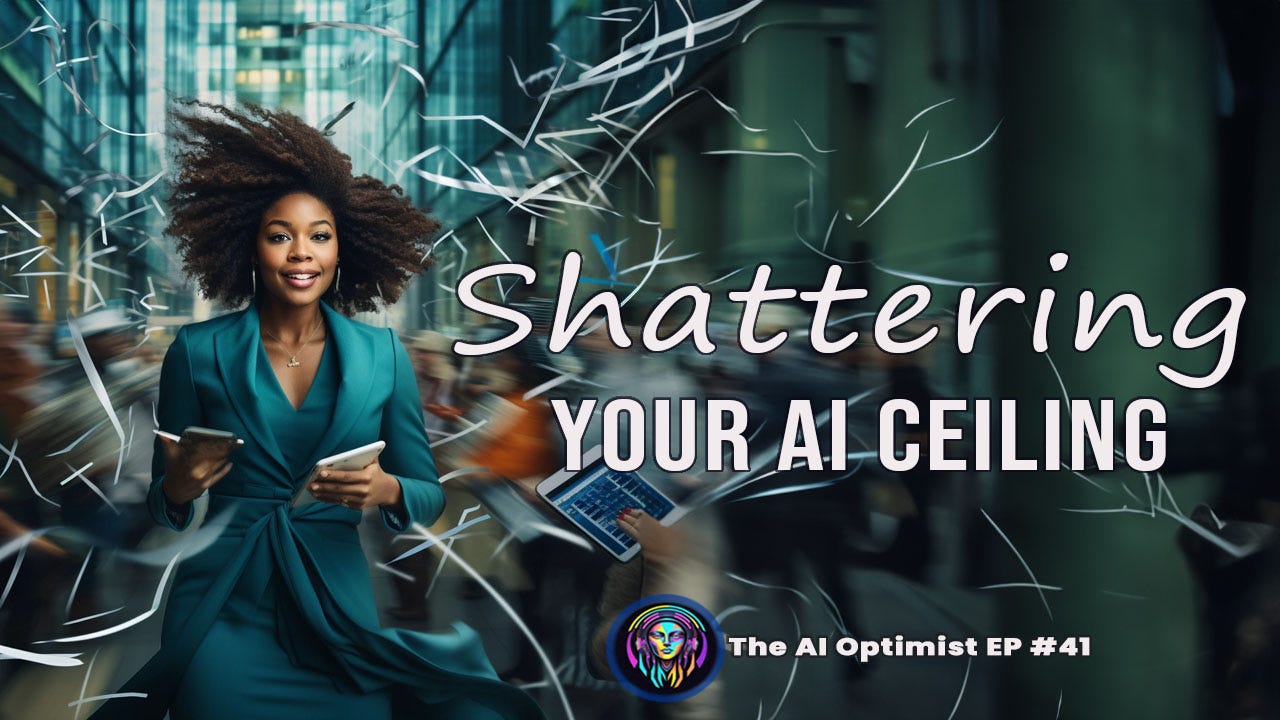Looks like everyone’s ahead of you with AI?
I'll let you in on a little secret.
You're either jumping headfirst into AI or telling employees to figure out what's got you excited.
That's what first movers do, but most people aren't first movers. And things move slowly.
The AI Optimist Episode 41 Playlist
https://www.theaioptimist.com/p/shattering-your-ai-ceiling-3-growth
00:00 Saving 3000 hours with AI - Asana
00:57 Growth Driver 1 - Intro AI Gently
03:42 The 3 Gaps - Optimism Transparency Resources - Rebecca Hinds
05:27 Growth Driver 2 - What data do you feed AI?
08:09 Growth Driver 3 - Most people don't get AI
11:17 Define your AI Floor and Ceiling
14:03 Where to Begin for Solopreneurs and Entrepreneurs
16:58 Small Business Floor and Ceiling measures
19:38 Guide people with AI, instead of expecting them to act like first movers
It's a gap causing many to remain unsure and at the floor, not rising to their potential, their ceiling.
This episode of the AI Optimists podcast focuses on helping small businesses and solopreneurs shatter their "AI ceiling" by providing three growth drivers for integrating AI effectively.
Sharing insights from companies like Asana, Holiday Extras, Affiliate.ai and Learning Frequency on how to introduce AI gradually, feed it quality data, and understand where employees or clients are starting from in terms of AI knowledge.
Summary:
The three key growth drivers covered are:
1) Introducing AI gently by engaging people to try it rather than an "AI-first" aggressive push that threatens them.
2) Ensuring you are feeding AI good quality, relevant data and getting compliance/privacy aspects covered upfront.
3) Understanding that most people aren't "early AI movers" and teaching/supporting them through the integration process based on their existing skills and mindsets.
Detailed Outline:
Growth Driver 1: Introduce AI Gently
Don't threaten people with an "AI-first" model
Example of Asana winning over employees gradually
Engage people, get team involved like Holiday Extras did
Address the "optimism gap" and "transparency gap" between execs and employees
Growth Driver 2: Focus on Quality Data for AI
Example of Learning Frequency using meaningful metrics
Assess what data matters, not just mass quantity
Get compliance/privacy sorted out early
Growth Driver 3: Meet People Where They Are
Most aren't "early AI movers", teach them based on their skills
Example of the intimidating "blank prompt" problem
For solopreneurs: Floor is admin/support automation, ceiling is personalized services
For small businesses: Floor is time savings, ceiling is new products/markets
Define your AI "floor and ceiling", measure performance consistently
Practical Suggestions
Don't take a "do-it-yourself" approach, guide and upskill people
Set benchmarks to measure true impact on costs, revenue, satisfaction
Review and adjust every 90 days
Best integrators are team-builders who get everyone excited, not just "geniuses"
Key Quotes:
"An AI-first model which says let's start with AI, see if we can just do it with that, really threatens people."
"Early ChatGPT users were so proud of the work they were doing, they couldn't help but tell colleagues - employee word of mouth on the quality work became an instant driver of adoption."
"It was fascinating that to me, it's almost like if I humanize it a bit, in big quotes. I'm just putting a picture on avatar, like Character.ai. It works because one of the big fears, is fear of the blank space in the prompt."
"Improve on common mistakes. And maybe a floor would be 10% improvement in speed to finishing your tasks, or a 5% reduction in cost due to automation."
"The ceiling for a small business transforms the business. Maybe enabling new products, making customer service way better...or opening new markets."
ASANA Won Back 3000 Hours
Future Work podcast
In Episode 41 we focus on Shattering your AI Ceiling: 3 Growth Drivers for Small Business and Solopreneurs
Growth Driver 1. Introduce AI gently, don't
throw it at people....like AI FIRST!
Instead of engineering speak, discuss in simple terms, and engage people to try it out.
We love to discuss sentimentality analysis of data, now let's talk about listening and guiding people to get the most out of AI....
And Holiday Extras is an Australian travel company following their employee's AI embrace:
Like a mini viral, word of mouth maybe movement, indicative of the pliable company culture:
Why aren’t more like Asana or Holiday Extras, or thousands of others?
Mostly it's a disconnect, as excited executives expect everyone will see things as they do, or a creator fixates on a single vision that few understand.
According to Rebecca Hinds, there are three big gaps between how executives and individual Contributors view the technology:
- Optimism Gap: Executives see the promise and potential of AI more than Individual Contributors do.
- Transparency Gap: Executives think they are more transparent in using AI than they are according to individual contributors.
- Resource (Training) Gap: 25% of executives say they provide AI training, but only 11% of ICs agree.
Leaders must close these three gaps to gain the benefits of AI in organizations.
Start with people and training, not simply AI. Identify the low hanging fruit of futile tasks that people have and can be automated.
Look at AI from the perspective of those who don’t get it. Help them.
Growth Driver 2. What's your AI's Diet - what data do you feed AI?
Yes, the game becomes more impactful.
Gamifying AI integration, making it fun,
starting with people and slowly adding
in what AI is needed.
Suggestions
Old data - is your YouTube video from 2010 really a match with your current business and brand?
Get Compliance involved first - privacy and security have undermined numerous ventures, that spent all this time to get integrated, but couldn't answer basic privacy questions.
Growth Driver 3. Most people don't get AI
DEFINE YOUR CUSTOMER, OR EMPLOYEE OR SELF, FLOOR AND CEILING
Measuring AI Success - pinpoint your floor and ceiling
Floors begin the process, ceilings develop over years
The "floor" is the minimum performance, and the "ceiling" is the top performance.
The floor is usually within the first few months, while the ceiling requires a few years of development.
Be careful of the tendency to play around with a bunch of tools and follow the leader.
Like Rebecca Hinds shared, since the views of the executives are often not clearly understood by the rest of the people who have to execute this...
Like here's AI, figure it out, right?
Work on your messaging and training, as around 25% might do a little training now.
Early on, guide to increases and improvements. DIY not recommended.
EVERY BUSINESS OPENS UP TO AI AT ITS OWN PACE
I run 2 programs, AI-S for solopreneurs, and AI-E for Entrepreneurs and small businesses.
Each with different ideas of "floor" and "ceiling" results from AI plans. Consider this like performance in training – enter and increase according to what you can do and will be able to do over time, because it does take time.
Estimated before, measured during, and summarized after for improvements.
Engineering/coding, financial, and marketing/sales are the 3 areas where change is rampant. AI cuts the entry level jobs, and middle level management. And more, remember, it’s all custom.
For a Solopreneur: It’s all admin, scheduling, and support
Floor: The floor for a solopreneur using AI involves basics like scheduling, customer support, and financial management, aiming for more time to focus on the core business. A floor metric could be reducing admin tasks by 20%.
Ceiling: AI enables developing personalized services or products. This might result in doubling the customer base or achieving a 40% increase in income because of more time to do what they are paid to do. With a Solopreneur, make sure you’re honest about the floor and see the ceiling as a work in progress…..some find higher and higher ceilings, others level off.
AI is all custom fits.
Numbers to Benchmark:
Time spent on administrative tasks.
Customer growth, maybe more time with things that matter?
Profit changes – seen some go down, keep an eye on it.
Level of service or product customization
Small Business: Time savings is low hanging fruit, revenue driven activities long term.
Floor: The minimum saves a few hours by automating simple tasks, freeing up time while improving on common mistakes. A floor for a small business might be a 10% improvement in speed or a 5% reduction in costs due to automation.
Ceiling: The best-case scenario transforms the business, enabling new products, enhancing customer service, or opening new markets. The ceiling might be a 50% increase in customer satisfaction scores or a 30% growth in revenue through new AI-driven services or products. Customize a solution to your business.
Metrics and KPIs:
Saving wasted time – LTVT (Long Term Value of Time)
Measuring reductions – actual time or percentage, increase in productivity by freeing up time, and training on what to do with the extra time.
Revenue growth – predictive analytics and the customer experience, moving from chatbots to people.
Customer ratings
Custom Fit means don’t rely on what others do. Their performance is no indicator of your future performance 😊
Defining the floor and ceiling for AI integration helps us understand where we are at, and where we hope to go. And review these regularly, every 90 days minimum.
Pick the metrics and KPIs that matter to you, and that AI is expected to impact.
Create measurements, benchmarks…history. Let it teach you how to improve in the future.
Review these benchmarks to ensure AI is aligning with your business.
Move beyond minimal AI results - the floor - and unearth counter intuitive AI strategies to your small business or solo venture. Know your limits, define your floor and ceiling, and start improving your results.
FICTIONAL BUSINESS EXAMPLE
Here is a sample use case study of a travel company using AI to connect with customers and employees:
Company Overview
Wanderlust Travel is a mid-sized travel agency that specializes in customized vacation packages. With 75 employees across their headquarters and multiple branch offices, Wanderlust was looking for ways to improve efficiency, enhance the customer experience, and empower their workforce.
The Challenge
Wanderlust faced some key challenges:
Keeping up with changing traveler demands and preferences
Providing personalized service at scale
Enabling seamless communication across departments and locations
Freeing up employee time from repetitive, manual tasks
Wanderlust recognized the potential of AI to help address these pain points, but was unsure of the best approach to integrate it effectively.
The AI Solution
After evaluating various options, Wanderlust decided on a multi-pronged AI strategy:
Customer-Facing Applications
Chatbot assistant to answer common queries, provide destination info 24/7
AI-powered recommendations for customized travel packages
Voice interfaces for making/modifying bookings
Internal Tools
Natural language processing to extract insights from customer communications
Automated workflow and task delegation based on employee skills/roles
AI training modules to upskill employees on using travel AI tools
Change Management
Dedicated AI integration team to guide roll-out
"Lunch and Learn" sessions to educate employees and get their feedback
Incentives for employees who developed new AI use cases
Execution and Results
Wanderlust adopted a phased approach, starting with the chatbot assistant and AI recommendations. Key results included:
Customer Impact
25% increase in bookings through the chatbot channel in 6 months
92% satisfaction rating for AI-recommended travel packages
Reduced response times from days to minutes for common queries
Employee Empowerment
Reallocated over 15,000 employee hours per year from manual tasks to higher-value work
Average employee upskilled with 3 new AI skills within first year
Over 20 new AI use cases identified and implemented by employees
By taking a holistic, people-centric approach to AI integration, Wanderlust was able to drive significant value for their customers and employees alike. Their methodology provides a template for other businesses looking to harness the power of AI responsibly and inclusively.
NOTE: This is not a real company. This report is shared to give an idea of how to evaluate AI for your business.

















